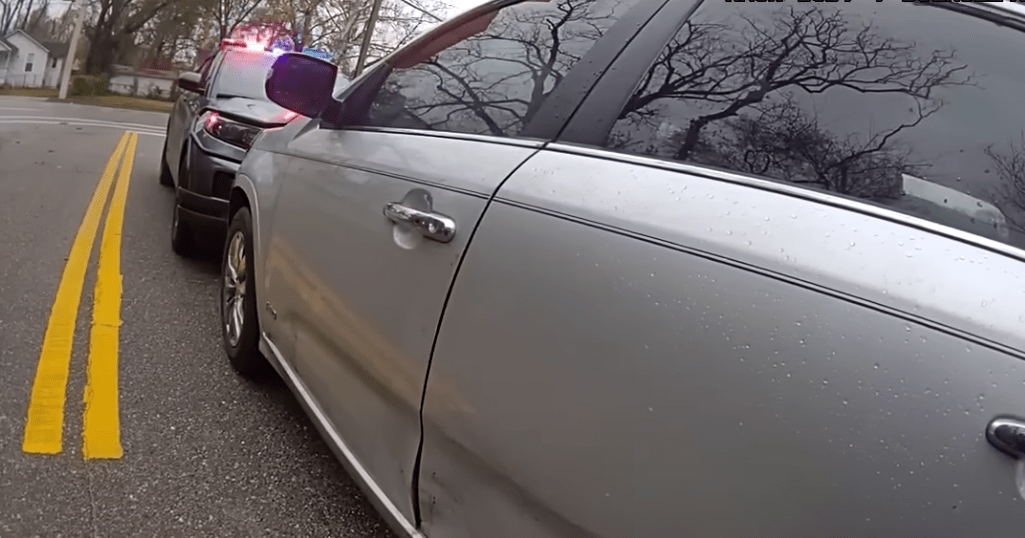William McNeil Jr., 22, was stopped by Officer Donald Bowers for what at first glance appeared to be a standard traffic stop on a mild February morning in Jacksonville. However, what transpired—which was caught on camera by the driver’s cellphone and bodycam—made a local incident national news, igniting legal discussions, public indignation, and a renewed focus on law enforcement tactics.
The video of the stop went viral by the middle of July. Throughout the video, McNeil can be seen sitting in his car and firmly but calmly refusing to get out. He keeps requesting a supervisor. Clearly irritated, Officer Bowers punches McNeil and smashes the driver’s side window before dragging him away. For people who are worried about using more force during police encounters, the moment—now immortalized on social media—has become a flashpoint.
Sheriff T.K. Waters confirmed at a press conference that Officer Bowers’ law enforcement authority had been revoked while an internal administrative review was conducted. The State Attorney’s Office did not file any criminal charges, but the public’s trust has been significantly damaged. Many people felt that Waters’ emphasis on obeying police orders regardless of one’s own opinions was contemptuous of McNeil’s physical and emotional suffering.
Officer Bowers – Key Bio and Career Details
| Attribute | Details |
|---|---|
| Name | Officer Donald Bowers |
| Department | Jacksonville Sheriff’s Office (JSO), Florida |
| Position | Law Enforcement Officer |
| Incident Date | February 19, 2025 |
| Suspension Status | Suspended pending internal administrative review |
| Known For | Viral traffic stop involving William McNeil Jr. |
| Public Criticism | Use of force during traffic stop; smashing window, punching civilian |
| Bodycam Released | Yes (Released by JSO on July 22, 2025) |
| Legal Status | Not criminally charged (per State Attorney’s Office review) |
| Reference | https://www.bbc.com/news/articles/c5kk2kg7y4go |

McNeil recently shared his own recording online, providing a chilling account of the event. He said in his caption that he had a concussion, facial stitches, and a chipped tooth. He wrote, “This was really difficult to do.” “Even though I haven’t recovered mentally from this, I had to spread the word eventually.” He is one of many Americans who have come to the conclusion that when it comes to dubious police behavior, silence is no longer an option.
Observers have discovered remarkably similar patterns in the way these cases develop when comparing this case to similar incidents, especially the tragic death of George Floyd. This sequence—first minimized, then acknowledged, and finally discussed on the legal and social fronts—is uncannily similar. Some justice or reform is brought about by sustained public pressure, but rarely with the complete accountability or transparency that victims desire.
Ben Crump, a civil rights lawyer with experience defending victims of police brutality, took on McNeil’s case. His participation increased national attention and legal weight. Crump emphasized the cultural heritage that influences Black men’s perceptions of policing in the US, calling the incident a “disturbing reminder” of racially charged violence. His remarks reverberated throughout the public opinion courtroom.
The video and the wider media reaction weren’t just a far-off controversy for Jacksonville locals. It compelled a more thorough examination. The city has made investments in officer training programs, transparency campaigns, and community policing during the last 12 months. However, Officer Bowers’ actions were a painful reminder that, despite its importance, reform is not always swift or distributed fairly.
Influencers and celebrities started answering by the middle of the week. The bodycam footage was reposted by Ava DuVernay with the caption, “Still happening.” I’m still exhausted. Jalen Rose and other NBA players advocated for mandatory de-escalation training, stating that routine traffic stops shouldn’t result in bloodied faces and broken glass. Their messages struck a deep chord with people of all ages, races, and political persuasions.
Officer Bowers’s own public statement is conspicuously missing from this developing story. Although he stated in his report that McNeil was “reaching toward the floorboard where a knife was sitting,” the video footage clearly shows McNeil’s hands raised. Particularly concerning is the disparity between documentation and visual evidence, which suggests possible disconnects between narrative control and real behavior.
The public now has unparalleled access to unfiltered events thanks to quickly developing transparency tools like bodycams and live streaming. Although that access is very helpful in exposing the truth, it also puts tremendous pressure on law enforcement to respond fairly, quickly, and decisively. Failing to do so can seriously damage public trust, especially in the era of viral media.
More community oversight panels could be established in Jacksonville through strategic alliances with civil organizations. Diverse viewpoints, especially from the communities most impacted by these incidents, could influence policy changes by integrating independent citizen reviews. Cities like Seattle and Atlanta, where public involvement has directly impacted policing standards, have already seen remarkable success with such initiatives.
Local leaders must now decide whether to continue using conventional approaches or seek out new avenues for justice and reconciliation in light of the recent momentum. A more well-rounded approach might be provided by a hybrid model that combines independent review, digital transparency, and updated training. Despite its pain, the Bowers case may still act as a spark for improved public safety practices.
McNeil’s tenacity serves as a potent metaphor in many respects. He made the decision to speak in spite of the harm to his body, the emotional toll, and the burden of structural injustice. For clarity, not for retribution. His story, which has been documented through statements, bruises, and social media posts, provides a profoundly human viewpoint that is frequently ignored in discussions of policy and statistics.

